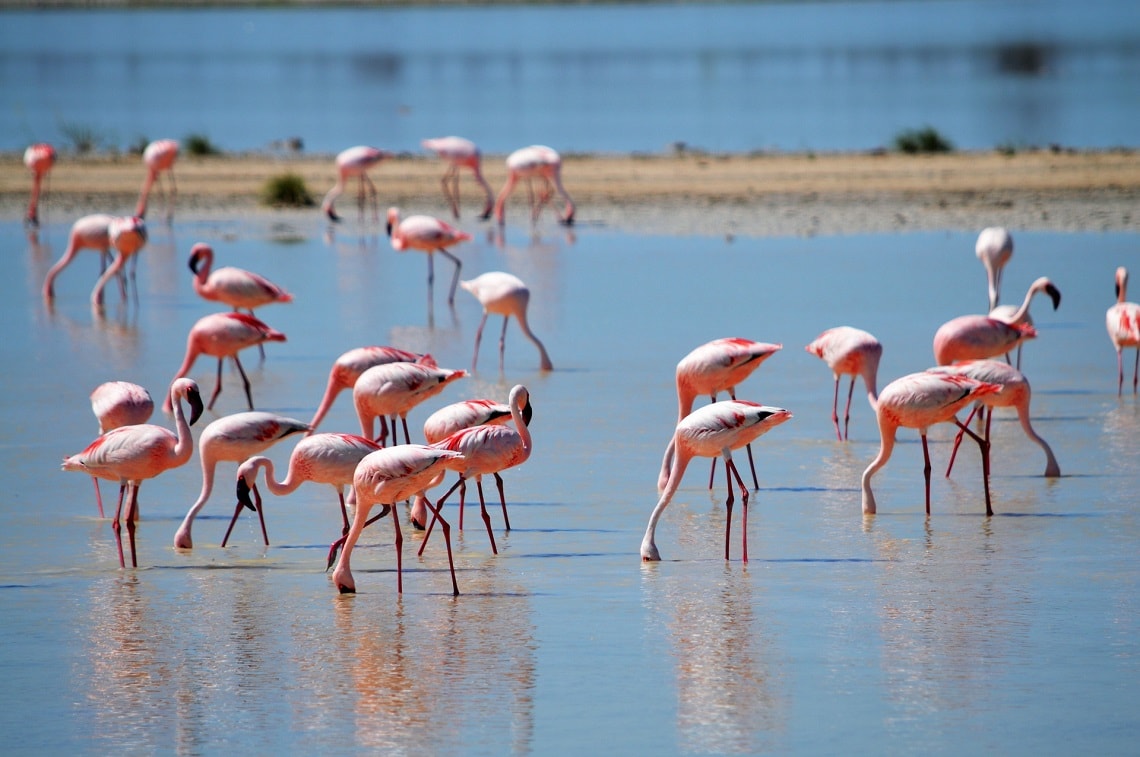Namibia may be mostly desert yet birders will find it anything but barren. If you’re looking to tick off special sightings, make your way to these destinations. And pack the Namibia bird book that suits beginners and experts alike. By Romi Boom
Namibia’s vast countryside is home to 110 endemic bird species – these are birds that are found nowhere else, or with their ranges extending just beyond the region. For a country that is mostly desert, the birding is surprisingly productive, with 21 important birding areas (IBAs) and five Ramsar wetlands.

You will see birds just about everywhere in Namibia, which has about 690 bird species in total. I’ve seen the highly restricted dune larks in the Namib desert, wattled cranes in Etosha National Park, a kleptoparasitic pelican on the Walvis Bay coast and the near-endemic Herero chat among the granite boulders of Spitzkoppe. These are just a few highlights from many trips on roads ranging from good, all-season surfaces to deep sand.


Birding hotspots in the northeast
My favourite birding destination in Namibia is the Okavango Panhandle. The signature wetland species in the Panhandle include African skimmer, slaty egret and swamp boubou. Then there’s the Zambezi region, formerly known as the Caprivi. Its eastern section especially, on the Kwando River, features floodplains, riverine forests and teak woodlands with many special ticks.
An entire lazy afternoon at Camp Kwando was spent admiring the liquid tones of the large, impressive coppery-tailed coucal in the bush adjacent to the river’s reedbeds, alongside our campsite. The loud tapping of a woodpecker was incessant. But which was it? Golden-tailed, Bennett’s, bearded and cardinal woodpecker occur in the region. Had I been armed with the new Pocket Guide Birds of Namibia (read more below), it would have been a cinch to identify it as a bearded woodpecker.

If you are travelling from east to west, spend time in the Mahango Game Reserve and Popa Falls on the Okavango River. This is one of southern Africa’s top birding destinations with 400 species, many of them sought-after.
T4A travel tip: Mahango Game Reserve’s river loop offers fantastic birding. It can be done in a normal 2WD and takes one to two hours. The reserve’s western loop is strictly for 4WD and takes at least two hours to complete.
Shop: Latest Namibia and Botswana Self-Drive Guide Books


Namibia’s flagship park
Don’t miss Etosha with its waterholes, grasslands, savannas and seasonally flooded salt pans in the wet summer months. The downside of visiting Etosha in summer is that the game is widely dispersed because plentiful water is readily available. The birding, on the other hand, is superb with large numbers of migrant birds, a wide range of ducks on the pans, as well as protected species such as wattled and blue cranes and several stork species.
T4A tip: Although Etosha’s good gravel road can usually be travelled in a sedan, during the rainy season a 4WD or pick-up truck is recommended.
At Halali Rest Camp, look out for near-endemics such as violet wood-hoopoe and Rüppell’s parrot. At Namutoni in the east your special tick will hopefully be the furtive black-faced babbler that tends to forage in scattered groups among leaf litter. The babbler’s bright yellow eye is diagnostic.
Along the coast
Moving on to Swakopmund and Walvis Bay on the coast, you’ll find the landscape lacking in trees. Gravel plains (tick Rüppell’s korhaan and Namaqua sandgrouse) and huge sand dunes characterise this inhospitable terrain. It nevertheless houses the most extensive coastal wetland in southern Africa. In summer, it hosts more than 100,000 waterbirds. A magnificent sight to behold are vast numbers of migrant waders and lesser and greater flamingos on tidal mudflats, salt pans and the Walvis Bay Lagoon (the locally common Damara tern is an easy tick).


Pocket Guide Birds of Namibia is a compact field-guide with full-colour photos showing the birds’ most identifying features. For each of the 350-plus species in the book there are English, Afrikaans, German and scientific names, as well as an up-to-date distribution map. Since the habitat in which a bird is found is often an important clue to its identity, a map shows the major vegetation zones.
Pocket Guide Birds of Namibia by Ian Sinclair, one of Africa’s foremost field birders, and Joris Komen, former curator of birds at the National Museum of Namibia, was published in July 2017 by Struik Nature, a division of Penguin Random House. RRP: R170.
All things Namibia
Planning a trip to Namibia? Make sure to get your hands on T4A’s Namibia Self-Drive Guide for more travel tips like these. The guide is packed with navigation advice, border post information, essentials when it comes to packing, guidelines on how to prepare your vehicle, and much more.


